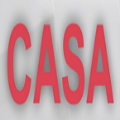Reconstructing sky models from dirty radio images for accurate source localization and flux estimation is crucial for studying galaxy evolution at high redshift, especially in deep fields using instruments like the Atacama Large Millimetre Array (ALMA). With new projects like the Square Kilometre Array (SKA), there's a growing need for better source extraction methods. Current techniques, such as CLEAN and PyBDSF, often fail to detect faint sources, highlighting the need for more accurate methods. This study proposes using stochastic neural networks to rebuild sky models directly from dirty images. This method can pinpoint radio sources and measure their fluxes with related uncertainties, marking a potential improvement in radio source characterization. We tested this approach on 10164 images simulated with the CASA tool simalma, based on ALMA's Cycle 5.3 antenna setup. We applied conditional Denoising Diffusion Probabilistic Models (DDPMs) for sky models reconstruction, then used Photutils to determine source coordinates and fluxes, assessing the model's performance across different water vapor levels. Our method showed excellence in source localization, achieving more than 90% completeness at a signal-to-noise ratio (SNR) as low as 2. It also surpassed PyBDSF in flux estimation, accurately identifying fluxes for 96% of sources in the test set, a significant improvement over CLEAN+ PyBDSF's 57%. Conditional DDPMs is a powerful tool for image-to-image translation, yielding accurate and robust characterisation of radio sources, and outperforming existing methodologies. While this study underscores its significant potential for applications in radio astronomy, we also acknowledge certain limitations that accompany its usage, suggesting directions for further refinement and research.
翻译:暂无翻译




